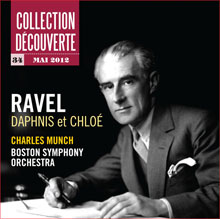Flash version here.
 In March, we featured Stravinsky’s ballet score Petrushka from 1911. This month we have another classic ballet score given its premiere just a year later, and in the same city—Paris. It turned out to be the largest project Ravel was to undertake during his lifetime (1875-1937), and the music is now in the repertoire of every major orchestra in the world.
In March, we featured Stravinsky’s ballet score Petrushka from 1911. This month we have another classic ballet score given its premiere just a year later, and in the same city—Paris. It turned out to be the largest project Ravel was to undertake during his lifetime (1875-1937), and the music is now in the repertoire of every major orchestra in the world.
Daphnis and Chloé is yet another masterpiece commissioned by the impresario Sergei Diaghilev, and was premiered by his Ballets Russes at the Théâtre du Châtelet June 8, 1912. The choreography was by Michel Fokine and the principal dancers were Vaslav Nijinsky and Tamara Karsavina. Pierre Monteux conducted. The orchestra required is enormous. The percussion section includes tam-tam, wind machine, castanets, tambourine, glockenspiel and much more. One of the most imaginative features of the orchestra is the wordless chorus. The effect is particularly striking in the opening scene and in the final bacchanale.
As a ballet, Daphnis and Chloé is divided into three scenes, however on the recording they are played without pause and each scene flows into the next. The famous Suite No. 2 is a much-played concert piece; it is, in fact, the entire last scene (Scene 3) of the ballet score.
Synopsis: The opening scene is a grotto in a woody landscape where young shepherds and shepherdesses gather round an antique sculpture of three nymphs. The couple Daphnis and Chloé appear, but the cowherd Dorcon takes an interest in Chloé and tries to win her affection. A shepherdess, Lyceion, attempts to seduce Daphnis. Pirates suddenly appear and carry off Chloé.
The second scene opens with a wild dance by the pirates at their camp. Chloé is led in by two pirates. She tries to flee but is brought back. Daphnis seeks help from the god Pan in finding Chloé and bringing her back. Pan and his followers descend on the pirate camp and frighten them off.
The third and final scene returns to the grotto we saw in scene one. It is dawn and we hear the wondrous music which opens the Suite No. 2. Chloé is brought back to the grotto by shepherdesses and reunited with Daphnis. In gratitude the lovers re-enact the story of Pan and Syrinx. Daphnis as Pan picks several reeds from the water nearby and forms a flute. While he plays we hear one of the greatest flute solos in all music and Chloé dances to its haunting melodies. The scene becomes more animated and all the shepherds and shepherdesses take part in a joyous bacchanale.
On record: The Boston Symphony has had a long association with Ravel’s Daphnis and Chloé. Monteux conducted it with the BSO on many occasions and Serge Koussevitsky did too. Then came Charles Munch, who was the first BSO conductor to record the work in its completion, in 1955. He made a second recording of the complete score in 1961, both for RCA Victor. The tradition continued with subsequent complete recordings by his successors Seiji Ozawa and James Levine, and the orchestra’s conductor laureate, Bernard Haitink, also recorded Daphnis with the BSO.
Charles Munch (1891-1968) had a very distinguished career. He was born in Strasbourg, which was part of Germany at the time, but then given back to France at the end of World War I. Following studies at the Strasbourg Conservatoire, Munch studied violin in Berlin with Carl Flesch and at the Conservatoire de Paris with Lucien Capet. World War I saw him conscripted into the German army where he was gassed and wounded. After the war, he resumed his career in music and ultimately became concertmaster of the Leipzig Gewandhaus Orchestra under Wilhelm Furtwängler and Bruno Walter.
Munch made his conducting debut at the age of 41 and built an important career, mostly in France. After the war he was able to travel more widely and became music director of the Boston Symphony from 1949 to 1962. He was noted for the excitement and spontaneity of his performances, and he was generally at his best in live performances.
The first full-length biography of Charles Munch was published just a few months ago (Holoman, D. Kern. Charles Munch. London: Oxford University Press, 2012). The publisher has also made additional material about Munch available on its website: www.oup.com/us/charlesmunch. To access this material you will need the User Name (Music1) and the Password (Book5983).
The 1955 BSO recording of Daphnis and Chloé is a wonderful performance and an important documentation of the quality of the orchestra at that time. The flute solo (track 20) is played by Doriot Anthony Dwyer, a distinguished artist and at that time the only female principal wind player in any of the leading American orchestras. Incidentally, Dwyer gets all the credit in the “flute solo” but Ravel cleverly composed this section to produce a seamless flute sound by using the second flute, piccolo and alto flute to help out here and there.
The trumpet section was led by Roger Voisin and Armando Ghitalla, and under Munch they played with electrifying virtuosity. They are on fire in the Dance of the Pirates (track 13) and in the Bacchanale (track 23).
Version française...

